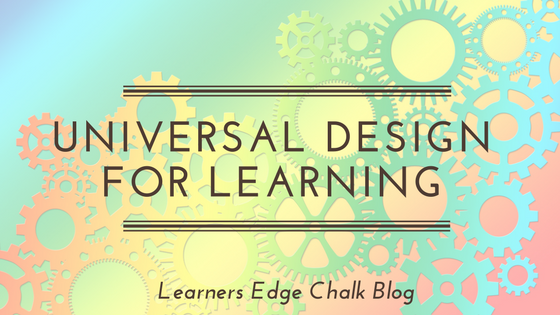Do you want to find a way to reach every student in your classroom? Are you trying to figure out how to decrease barriers to learning? Do you want to be more flexible in your teaching? You might want to consider Universal Design for Learning!
But, what is Universal Design for Learning?
Universal Design for Learning (UDL) is organized around three ideas which align with how the brain learns.
- The first principle provides multiple means for engagement of students which correlates to the affective network in the brain impacting the “why” of learning (i.e. motivation, purpose of learning, etc.)
- The second principle provides multiple means of representation which lines up with the recognition network of the brain. This is the “what” of learning (i.e. options for comprehension or intake of info.)
- The third principal provides multiple means of action and expression. The “how” of learning is related to the strategic network of the brain and means that educators need to find ways to allow for different ways to express knowledge gained.
Every child needs motivation, opportunities to take in information and ways to express that learning!! One way to ensure this is to incorporate UDL principles into your lesson planning. Patti Kelly Ralabate, the author of Your UDL Lesson Planner, states, “…the realities of today’s diverse classrooms and the expectations that all educators can and must be able to address the learning needs of all learners” is a major reason for teachers to use UDL frameworks in lesson design.
This can be done by following these steps:
- Define learning goals using flexible verbs and share the goals with the students. Flexible verbs allow all learnersan opportunity to obtain the goal. For example, instead of saying, “Students will write a summary,” you can say, “Students will summarize…” This allows for multiple ways for students to express their knowledge and doesn’t constrict for students who may struggle with writing.
- Recognize the differences in learners. There are so many variables in how students are motivated, interact with information and ultimately are able to show their learning. Students have different strength and weakness profiles; they process information differently; they have different interests; they even are motivated by different things. No two individuals are the same, so why would we build one lesson?
- Assessment should be aligned with goals and also be used to drive instruction. There should be assessment of learning (summative) and for learning (formative.) Rubrics are helpful for both purposes.
- Infuse UDL strategies into your research based instructional methods. For example, if you often lecture, you could use a graphic organizer to allow students to take notes for a visual representation or include brief discussions and reflective opportunities as not all students process auditory.
- Choose to use materials and media that add value. You want to make these decisions based on how well the resource helps ALL learners achieve the learning goal. Remember, these can be high tech AND low tech.
- Reflection is imperative. After you have taught the lesson you planned, ask yourself what went well and what needs to change. Did ALL students meet the learning goal? What do you need to revise to make the lesson more powerful next time?
Bottom line? If we want EVERY student to be successful in school, we can no longer just teach to the middle. UDL offers a way to increase the likelihood that ALL students succeed.
Looking todive more into Universal Design for Learning? Enroll in Learners Edge Course #5035: Using Universal Design for Learning (UDL) in Lesson Planning and establish ways to combine the powerful processesand strategies of UDL with lesson planning to ensure you are meeting the needs of EACH learner.






